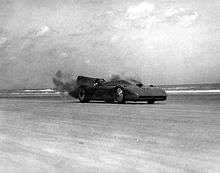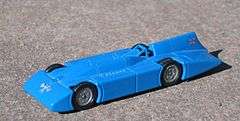Campbell-Railton Blue Bird
| Campbell-Railton Blue Bird | |
|---|---|
|
| |
| Overview | |
| Manufacturer | bodywork by Gurney Nutting |
| Production | one-off (1933) |
| Designer | Reid Railton |
| Body and chassis | |
| Body style | front-engined land speed record car. |
| Related | Campbell-Napier-Railton Blue Bird |
| Powertrain | |
| Engine | 2,300 hp 36.7 litre supercharged Rolls-Royce R V12 |
| Dimensions | |
| Wheelbase | 13ft 8in (4.17 m), Track front 5ft 3in (1.60 m), rear 5 feet (1.5 m) |
| Length | 27 feet (8.2 m) |
| Curb weight | 95 cwt (4.75tons) |
The Campbell-Railton Blue Bird was Sir Malcolm Campbell's final land speed record car.
His previous Campbell-Napier-Railton Blue Bird of 1931 was rebuilt significantly. The overall layout and the simple twin deep chassis rails remained, but little else. The bodywork remained similar, with the narrow body, the tombstone radiator grille and the semi-spatted wheels, but the mechanics were new. Most significantly, a larger, heavier and considerably more powerful Rolls-Royce R V12 engine replaced the old Napier Lion, again with supercharger.[1] This required two prominent "knuckles" atop the bodywork, to cover the V12 engine's camboxes.[2][3][4]
1933
|
| |
|
|
Blue Bird's first run was back at Daytona, setting a record of 272 miles per hour (438 km/h) on 22 February 1933.
Campbell now had a car with all the power that he could want, but no way to use all of it. Wheelspin was a problem, losing perhaps 50 miles per hour (80 km/h) from the top speed.[1]
1935


|
| |
|
| |
|
Note the airbrake actuating cylinder[7] |
Visually the car was quite different. The bodywork was now rectangular in cross section and spanned the full width over the wheels. Although actually higher, this increased width gave the impression of a much lower and sleeker car, accentuated by the long stabilising tailfin and the purposeful raised ridges over the engine camboxes.[8] This Blue Bird was clearly a design of the Modernist '30s, not the brute heroism of the '20s.[5][6]
Mechanically the changes to the car had focussed on improving the traction, rather than increasing the already generous power. Double wheels and tyres were fitted to the rear axle, to improve grip.[9] The final drive was also split into separate drives to each side. This reduced the load on each drive, allowed the driver position to be lowered, but required the wheelbase to be shortened asymmetrically on one side by 1½"(37 mm).[7] Airbrakes were fitted, actuated by a large air cylinder. For extra streamlining the radiator air intake could be closed by a movable flap, for a brief period during the record itself.[10]
Blue Bird made its first record runs back on Daytona Beach in early 1935. On 7 March 1935 Campbell improved his record to 276.82 miles per hour (445.50 km/h), but the unevenness of the sand caused a loss of grip and he knew the car was capable of more.[11]
The faster car needed a bigger and smoother arena, and this led to the Bonneville Salt Flats of Utah. This time the young Donald Campbell accompanied his father. On 3 September 1935, the 300 mph barrier fell by a bare mile-per-hour, that being 484,955 km, crowning Sir Malcolm Campbell's record-breaking career.[12][13]
Survival today
Alabama Motor Speedway Hall of Fame, Talladega, Alabama, USA
There is a replica in the Campbell gallery at the Lakeland Motor Museum, England.
The original is located at Daytona speedway circuit Museum.
References
- 1 2 "Blue Bird 1933". Bluebird team racing.
- 1 2 "1933 Blue Bird". Brooklands photo archive.
- 1 2 "1933 Blue Bird from the rear". Brooklands photo archive.
- ↑ "Blue Bird, 1933". many period photos
- 1 2 "Running at Brooklands". Brooklands photo archive.
- 1 2 "On the banking at Brooklands". Brooklands photo archive.
- 1 2 "Engine and chassis in the workshops, bodywork removed. Note the airbrake actuating cylinder.". Brooklands photo archive.
- ↑ "Bluebird 1935". Bluebird team racing.
- ↑ "Cockpit, showing the double wheels and also the airbrake flaps". Brooklands photo archive.
- ↑ "Blue Bird, 1935". Racing Campbells.
- ↑ "Blue Bird at Daytona, 1935". many period photos
- ↑ Holthusen, Peter J.R. (1986). The Land Speed Record. ISBN 0-85429-499-6.
- ↑ "Bluebird at Bonneville, 1935". Archived from the original on 2007-05-05. many period photos
- "record-breaking Pendine Sands". Sand Speed Wales. Archived from the original (photos) on 9 September 2010. Many rare period photos.